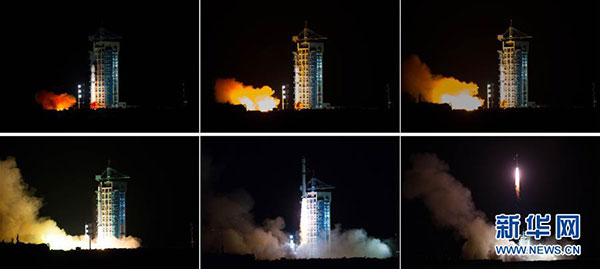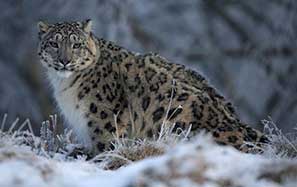China launches first-ever quantum communication satellite
 |
|
China successfully launched the world's first quantum satellite from the Jiuquan Satellite Launch Center in northwestern Gobi Desert at 1:40 am on Tuesday. [Photo/Xinhua] |
China launched the world's first quantum-enabled satellite in the early morning hours of Tuesday, marking the first step in building a space-based quantum communications network that is virtually un-crackable.
The 631-kg satellite, which is named after the ancient Chinese philosopher and scientist Micius, lifted off at 1:40 am atop a Long March 2D rocket from the Jiuquan Satellite Launch Center in northwestern China. It will operate 500 km above the Earth's surface for at least two years.
It is the third in a row of the Chinese Academy of Sciences' space science satellite firsts, following the Dark Matter Particle Explorer satellite that will help scientists deepen their understanding of the past and future of galaxies and the universe and Shijian 10, which carried out a series of experiments in microgravity in space for physical and life sciences, according to the academy.
Research has shown that it is practically impossible to crack, intercept or wiretap quantum communications because its physical traits mean it cannot be replicated, separated nor reverse engineered. Any attempt to interfere with its transmissions will leave a mark, disrupt the communication and result in parties involved being warned.
In addition to China, researchers in Austria, Germany, Singapore, Britain, Canada and Italy are also developing quantum-enabled communications technologies, they said.
Expected to change human communication
The satellite, Quantum Experiments at Space Scale (QUESS), will circle the Earth once every 90 minutes after it enters a sun-synchronous orbit at an altitude of 500 kilometers.
It is nicknamed "Micius," after a fifth century BC Chinese philosopher and scientist who has been credited as the first one in human history conducting optical experiments.
In its two-year mission, QUESS is designed to establish "hack-proof" quantum communications by transmitting uncrackable keys from space to the ground, and provide insights into the strangest phenomenon in quantum physics -- quantum entanglement.
Quantum communication boasts ultra-high security as a quantum photon can neither be separated nor duplicated. It is hence impossible to wiretap, intercept or crack the information transmitted through it.
With the help of the new satellite, scientists will be able to test quantum key distribution between the satellite and ground stations, and conduct secure quantum communications between Beijing and Xinjiang's Urumqi.
QUESS, as planned, will also beam entangled photons to two earth stations, 1,200 kilometers apart, in a move to test quantum entanglement over a greater distance, as well as test quantum teleportation between a ground station in Ali, Tibet, and itself.
"The newly-launched satellite marks a transition in China's role -- from a follower in classic information technology (IT) development to one of the leaders guiding future IT achievements," said Pan Jianwei, chief scientist of QUESS project with the Chinese Academy of Sciences (CAS).
The scientists now are expecting quantum communications to fundamentally change human development in the next two or three decades, as there are enormous prospects for applying the new generation of communication in fields like defense, military and finance.
- Is it a thing? 10 odd jobs where you can make good money
- Message on a bottle: Mineral water company launches drive to find missing children
- Sun Yat-sen champion of national integrity, unity: Xi
- Four killed, two injured after house collapses in C China
- Cross-Straits forum held to commemorate Sun Yat-sen

















